Energy efficiency has come a long way in recent years and is now one of the biggest things people look for when buying a new appliance. But which appliances are the most energy efficient in Australia? We’ve gone through the huge selection of whitegoods available from Appliances Online to find the most energy-efficient appliances – from refrigerators to washing machines – so you’ll know what to look for when you next go shopping.
Here are some of the most energy-efficient appliances in Australia for 2024:
On this page:
Most energy-efficient fridges
Fridges are pretty easy to figure out. Often, the smaller the fridge, the more energy efficient it is, but it still pays to refer to the energy rating of each fridge that you’re looking at. Luckily for shoppers more brands are starting to work on their energy efficiency for larger models, with the likes of Hisense and Liebherr leading the charge.
Hisense 483L PureFlat Bottom Mount Refrigerator (HRBM483B)
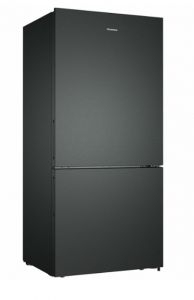
The Hisense isn’t very ‘white goods-y’ at all – in fact, it’s finished with black steel. It stands at 1756mm in height and has a width and depth of 794mm and 675.5mm respectively. Its fridge volume is 344L and its freezer volume is 139L. Most importantly, this model has been engineered for efficiency, coming in with one of Australia’s highest energy-efficiency ratings for fridges with six stars. To aid in this six-star rating, Hisense’s inverter and multi-air flow technology maintains the ideal temperature for cooling, making for a quieter and more efficient product.
In addition to a high energy rating, this fridge also features reversible doors, which allows it to be seamlessly integrated into any home design or space. Overall, expect this fridge to cost you about $1,699 (RRP).
- 6 stars for energy efficiency
Liebherr 321L Bottom Mount Fridge (CNEF4315)
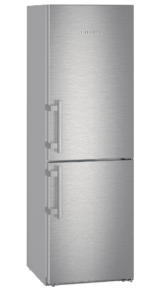
For a smaller model, you might consider this 321L unit from Liebherr which is rated 5.5 stars for energy efficiency. This model is equipped with Liebherr’s NoFrost feature to aid with the safe long-term storage of food and LED lighting to help with energy efficiency. It offers 321L total capacity with 220L available for the fridge and 101L for the freezer zone, making it better suited to a smaller household.
This model comes in a stainless-steel finish with Liebherr’s SoftSystem technology that allows the door to be opened up to 115 degrees. Overall, expect this fridge to cost $5,025 (RRP). While that does place it at the premium end of the fridge world, the high energy efficiency may just help you to save on your next energy bill.
- 5.5 stars for energy efficiency
Most energy-efficient dishwashers
With all the different types available, buying a dishwasher can definitely be a confusing process. From integrated, to freestanding, dish-drawers and so on, the options may seem endless, even before you begin considering energy efficiency.
That being said, there are two main players making it easy when it comes to energy-efficient dishwashers available in Australia. These are V-Zug and Haier.
V-ZUG AdoraDish V6000 Fully Integrated Dishwasher with Heat Pump (4112100007)
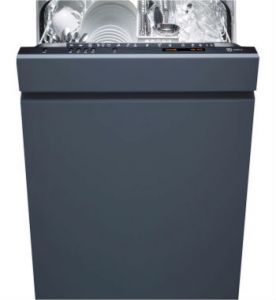
Knocking its energy-efficiency rating out of the park with a perfect six, the AdoraDish features 12 washing programs including an eco and glass wash cycle function. Its OptiStart features adds an ‘extra dimension’ to the delay start feature by wetting the dishes prior to start time, helping to soften the dirt and grime which allows the machine to run at a lower temperature. This feature is claimed to reduce energy consumption by 10%.
The unit is less than 900mm tall and operates at 43 decibels. It earned a six-star energy rating and uses a low 111kWh of energy each year, on average. It also boasts a five-star water rating using just 11.2L per cycle. Expect to pay a fairly hefty sum of around $6,500 (RRP) for this dishwasher, but for top quality and energy efficiency, you may find the price is worth it.
- 6 stars for energy efficiency
- 5 stars for water efficiency
Haier Freestanding Dishwasher with Steam Satina (HDW15F3S1)
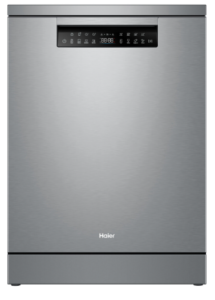
Designed with the family in mind, this Haier freestanding dishwasher is suitable to larger households or those who love to entertain. Coming with eight wash programs, this unit has earned a 4.5-star energy-efficiency rating and consumes on average 206kWh of energy a year. In terms of water efficiency, it has earnt a 5.5-star rating using just 11.1L per cycle. Additionally, it operates at a low noise level of 44 decibels, making it one of the quieter washers on the market.
While it might not have the same energy-efficiency rating as the V-ZUG model above, it can be had for a sixth of the price at $983 (RRP).
- 4.5 stars for energy efficiency
- 5.5 stars for water efficiency
Most energy-efficient washing machines
There’s a great divide in the washing machine world: Are you a front loader or a top loader household? Each type has its benefits and drawbacks, but as far as all-out energy efficiency is concerned, you can’t really go past a front loader. Two such front loader brands to dominate the rankings are V-ZUG and Electrolux. Let’s see how both brands fared.
V-ZUG AdoraWash V6000 8kg Front Load Washing Machine (1102510010)
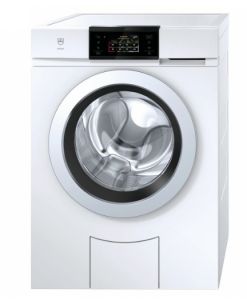
With 8kg capacity, this V-ZUG AdoraWash front loader gets a near perfect 5.5 stars for energy efficiency and four stars for water efficiency. It contains a massive 18 pre-programmed functions, and perhaps most noteworthy, a delayed start function. This gives households the ability to select the time they want to start their wash, allowing for use of cheaper off-peak energy prices if applicable.
It boasts an average energy consumption of 148kWh a year and uses 69L of water a cycle. With a price tag of $6,700 (RRP) it’s definitely a high-end washing machine, but the trade-off is more efficient operation.
- 5.5 stars for energy efficiency
- 4 stars for water efficiency
Electrolux 10kg Front Load Washing Machine with SensorWash (EWF1042R7WB)
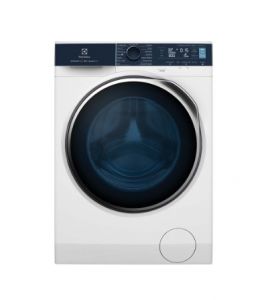
This front loader from Electrolux is another model to boast a five-star energy-efficiency rating. It features 15 wash programs including wool and sports. On top of that, it’s designed with a gentle drum, which has smaller holes for the quick moving water to pass through, reducing the risk of pulling for your clothes whilst on high-speed spinning cycles.
This model has an average annual energy consumption of 218kWh. As for water, it uses 86L per wash, giving it a 4.5-star water-efficiency rating. With 10kg of washing capacity, it is ideal for a family, retailing for $1,649 (RRP).
- 5 stars for energy efficiency
- 4.5 stars for water efficiency
Compare cheap electricity plans
Here are some of the cheapest published deals from the retailers on our database that include a link to the retailer’s website for further details. These are products from referral partners†. These costs are based on the Ausgrid network in Sydney but prices may vary depending on your circumstances. This comparison assumes general energy usage of 3911kWh/year for a residential customer on a single rate tariff. Please use our comparison tool for a specific comparison in your area. Our database may not cover all deals in your area. As always, check all details of any plan directly with the retailer before making a purchase decision.
Here are some of the cheapest published deals from the retailers on our database that include a link to the retailer’s website for further details. These are products from referral partners†. These costs are based on the Citipower network in Melbourne but prices may vary depending on your circumstances. This comparison assumes general energy usage of 4000kWh/year for a residential customer on a single rate tariff. Please use our comparison tool for a specific comparison in your area. Our database may not cover all deals in your area. As always, check all details of any plan directly with the retailer before making a purchase decision.
Here are some of the cheapest published deals from the retailers on our database that include a link to the retailer’s website for further details. These are products from referral partners†. These costs are based on the Energex network in Brisbane but prices may vary depending on your circumstances. This comparison assumes general energy usage of 4613kWh/year for a residential customer on a single rate tariff. Please use our comparison tool for a specific comparison in your area. Our database may not cover all deals in your area. As always, check all details of any plan directly with the retailer before making a purchase decision.
Here are some of the cheapest published deals from the retailers on our database that include a link to the retailer’s website for further details. These are products from referral partners†. These costs are based on the SA Power network in Adelaide but prices may vary depending on your circumstances. This comparison assumes general energy usage of 4011kWh/year for a residential customer on a single rate tariff. Please use our comparison tool for a specific comparison in your area. Our database may not cover all deals in your area. As always, check all details of any plan directly with the retailer before making a purchase decision.
Most energy-efficient dryers
Let’s face it, clothes dryers are never going to be the most energy-efficient appliances. Not all are made equal: however, as far as efficiency goes, you can’t really beat a heat pump dryer. Heat pump dryers basically work in reverse of an air conditioner – they bring warm air from outside to dry the clothes.
Did you think the energy-efficiency scale only went to six? We hate to break it to you, but you’d be wrong – the scale actually extends up to 10 for some appliances, with those scoring 5.5 stars or more deemed to be ‘super-efficient’. Two brands that are drying up the competition are LG and Asko.
LG 8kg Heat Pump Dryer with Inverter Control (DVH5-08W)
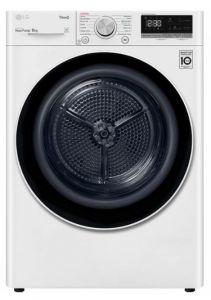
Enter this heat pump clothes dryer from LG with a whopping nine stars for energy efficiency. It comes with 14 different drying programs, including specific cycles for both delicate clothes and sportswear, plus it has 8kg of drying capacity
While it is costly compared to some other dryers at $2,039 (RRP), the energy efficiency trade-off might be worth it in the long-run.
- 9 stars for energy efficiency
ASKO 10kg Heat Pump Dryer (T410HD.W)
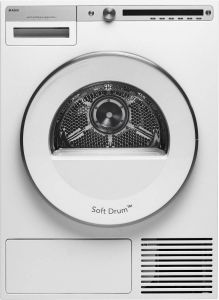
Scandinavian manufacturer ASKO is another brand offering a clothes dryer with a nine-star energy-efficiency rating. It offers 14 different drying programs with anti-crease, low-temperature and wool specific options. Other settings include everything from preventing clothes bundling to time saving programs.
All this does come with a price though, with this model retailing for $2,999 (RRP). But your energy savings from this appliance might help pay it off over time.
- 9 stars for energy efficiency
Most energy-efficient air conditioners
Perhaps the most notorious for energy inefficiency are air conditioners. You generally have to be careful with these appliances as running air conditioners constantly can blow out your power bill. Some are worse than others, but luckily brands such as Kelvinator and Rinnai are working to change air conditioners’ bad raps.
It is important to note that with an air conditioner, particularly with reverse cycle systems, you may find that there is a different energy-efficiency rating for cooling and heating.
Kelvinator 2.5kW Split System Reverse Cycle Inverter Air Conditioner (KSD25HWJ)
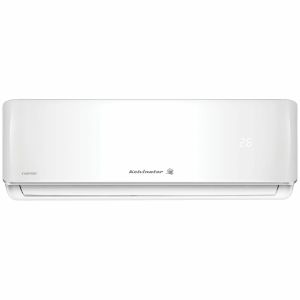
For one of the best air conditioners on the market you can’t go past Kelvinator’s 2.5kW Split System Reverse Cycle and its high energy-efficiency rating (five stars for cooling, five stars for heating). It’s packed with features such as three filters to help ventilate and purify the air, sleep mode and an innovative Follow Me function which detects when you enter the room and adjusts the temperature accordingly.
The Kelvinator’s advanced inverter technology also makes for a quiet unit, emitting no more than 46 decibels inside the home. It also has an optional app function that lets you control all settings from your smartphone or tablet. At 2.5kw, it’s a smaller-sized unit probably best suited to a small room or study. You can expect to pay $1,149 (RRP) for this model.
- 5 stars for energy efficiency (cooling)
- 5 stars for energy efficiency (heating)
Rinnai 5.2kW Split System Air Conditioner (HSNRT50B)
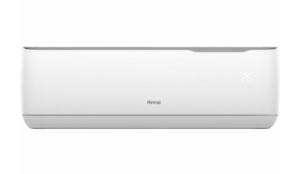
If you are after a larger unit, this Rinnai 5.2kW air conditioner features a bunch of energy saving technologies including a timer and self-cleaning function. It also comes with a sleep mode that uses a two-way temperature control to mimic ambient temperatures for comfortable sleep conditions.
This unit is rated 4.5 stars for cooling and three stars for heating when it comes to energy efficiency. It is also one of the more costly units at $2,094 (RRP) thanks to its size. But if it’s heating and cooling for a large space you are after, then this 5.6kW unit might be one for you.
- 4.5 stars for energy efficiency (cooling)
- 3 stars for energy efficiency (heating)
Most energy-efficient TVs
TVs have become an essential appliance for Aussie homes, but even on standby, TVs can chew up a large amount of energy. While a high energy-efficiency rating in a TV is hard to find, brands like TCL and LG have attempted to lead the charge. See what these two brands have to offer below.
TCL 65-Inch P745 4K UHD QUHD Smart Google TV (65P745)
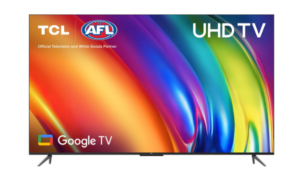
Although high energy-efficiency ratings are hard to come by in TVs, one which comes close, at the time of writing, is this TCL unit with a six star energy rating for $1,099 (RRP). It features 4K Ultra HD resolution and HDR10+ technology to help enhance the viewing experience, as well as Dolby Atmos audio technology for a ‘multidimensional’ sound experience.
With Google TV built in, households can also easily view content from video streaming apps, including Netflix, Stan, Amazon Prime and YouTube, on this device.
- 6 stars for energy efficiency
LG 75-Inch QNED75 4K UHD Smart LED TV (75QNED75SRA)
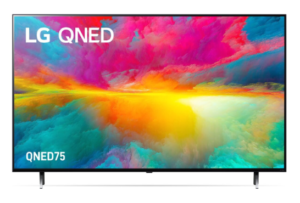
This 75-inch TV from LG has an energy-efficiency rating of six stars. It features AI Brightness Control that automatically adjusts to your screen’s brightness for optimal visibility in any environment and AI Sound Pro that is said to elevate the audio experience.
LG’s product also comes with compatibility with Google Assistant, Amazon Alexa and AirPlay2 smart home systems. Streaming services Netflix and Stan can also be operated on this device. You can pick this model up for $2,499 (RRP).
- 6 stars for energy efficiency
You might also be interested in:
Are these energy-efficient appliances right for me?
Although these appliances are undoubtedly very energy efficient, they are also very costly. Before buying the latest and greatest appliances, it’s worth considering how long it’ll take to recoup the cost of the unit price versus the actual energy savings over time. One thing is for sure, the next time you go shopping for new home appliances, you’ll hopefully be better informed about what energy efficiency really looks like.
When in doubt, you can always look for the star ratings sticker. It’s also important to do some research on the appliances you’re in need of in relation to your household size.
Forking out big bucks on a new energy-efficient appliance will only go so far if you are still on a dud energy plan, so be sure to compare a range of providers using our free comparison tool below. Just click the link, add your postcode and you’re good to go.
FAQs about energy-efficient appliances
The best way to determine which appliance will be the most energy efficient is through the star ratings sticker found on the box or appliance itself. Thanks to a Federal Government initiative to help consumers, most appliances – mainly whitegoods – are required to have an energy ratings label displayed. This rating is usually out of six stars (although some do go up to 10) and measures the appliance’s approximate annual energy consumption. Appliances with the lowest annual energy consumption will typically have the highest star rating and thus be the most energy efficient, but it’s best to compare all the specifications to ensure it will be the most energy efficient for you.
To improve the energy efficiency of your appliances it’s best to see if they are already considered energy efficient. You might find that some of the older appliances in your home, though sturdy and dependable machines, are eating up your power bill, so switching to more energy-efficient appliances where you can could be a way to ensure maximum energy efficiency.
If it’s not in the budget to switch your pre-existing appliances over to energy-efficient products, then there are still some things you can be doing to improve the energy efficiency of your appliances. This could include running it on a shorter, more eco-friendly cycle, turning it off at the switch when it’s not in use (if that’s possible) and using cold water as opposed to hot when you can.
Avoiding second-hand appliances where you can will also improve energy efficiency. These products tend to be less energy efficient and could be more likely to break in a shorter amount of time.
Energy-efficient appliances that have been purchased by an individual in a store generally won’t be tax deductible. However, there are certain rebates and schemes across Australia that reward certain energy-efficient purchases.
Here are the current energy-efficient schemes and rebates available for residents as of January 2024:
VIC: Receive discounts and special offers to help cover cost of replacing fridges and freezers, heating and cooling, hot water systems, lighting, TVs, clothes dryers, pool pumps and in home energy displays under the Victorian Energy Upgrades program. Conditions apply.
QLD: Receive financial incentives when installing energy-efficient air conditioning through the PeakSmart air conditioning program. Available on the Energex and Ergon Energy network. Conditions apply. The QLD Government also offered financial assistance through the Climate Smart Energy Savers scheme. This program however, has now closed.
NSW: Receive financial incentives for switching to energy-efficient LED lights, air conditioning units, hot water systems or pool pumps through the NSW Government’s Energy Savings Scheme. Conditions apply.
ACT: Receive financial incentives for upgrading to energy-efficient products through the ACT Government’s Home Energy Support Program. Interest-free loans are also available through the government’s Sustainable Household Scheme. Conditions apply.
SA: Receive free or discounted energy updates from eligible energy retailers that participate in the Retailer Energy Productivity Scheme (REPS). Conditions apply.
TAS: Access an interest-free loan for the purchase of energy-efficient products through the Tasmanian Government’s Energy Saver Loan Scheme. Conditions apply.
For a full list of terms and conditions for these rebates, please visit the respective government sites.

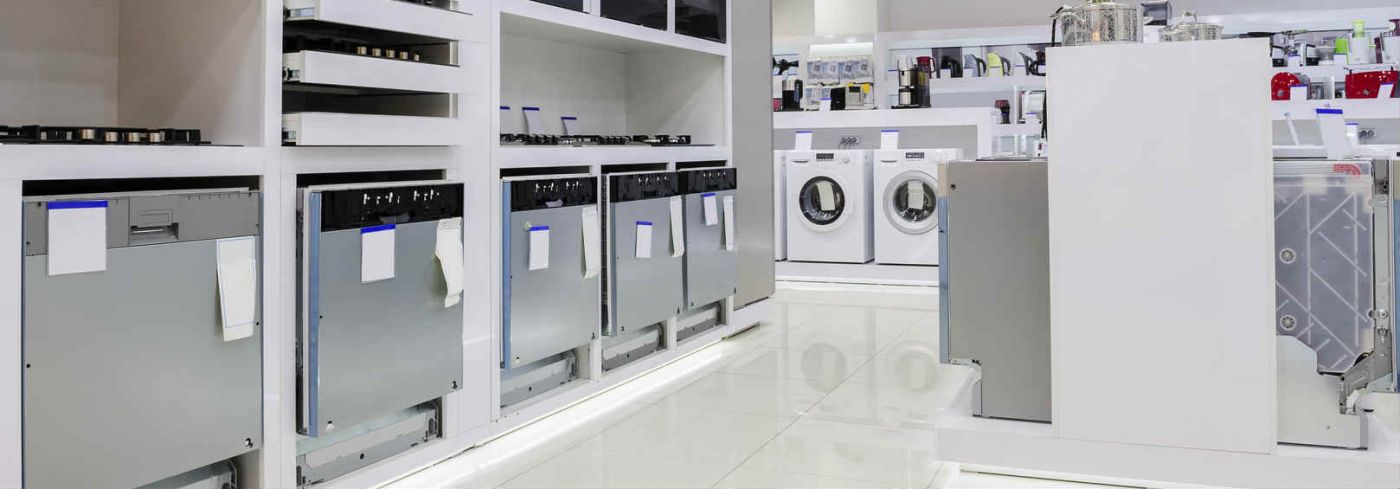




Share this article